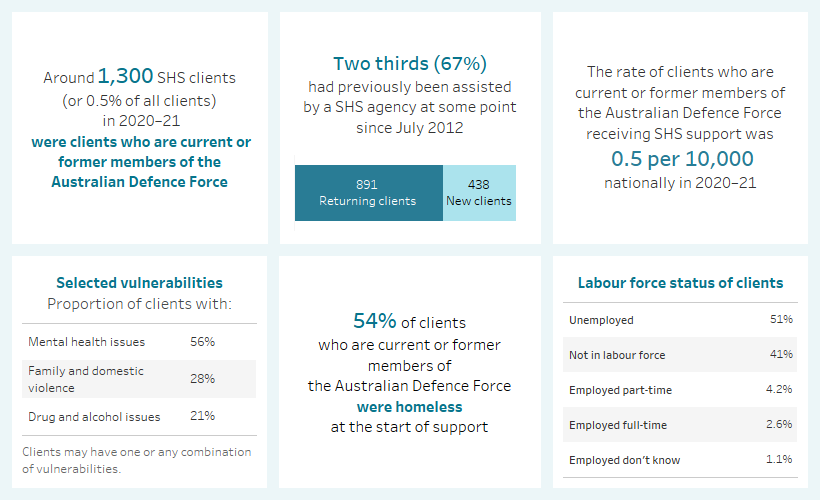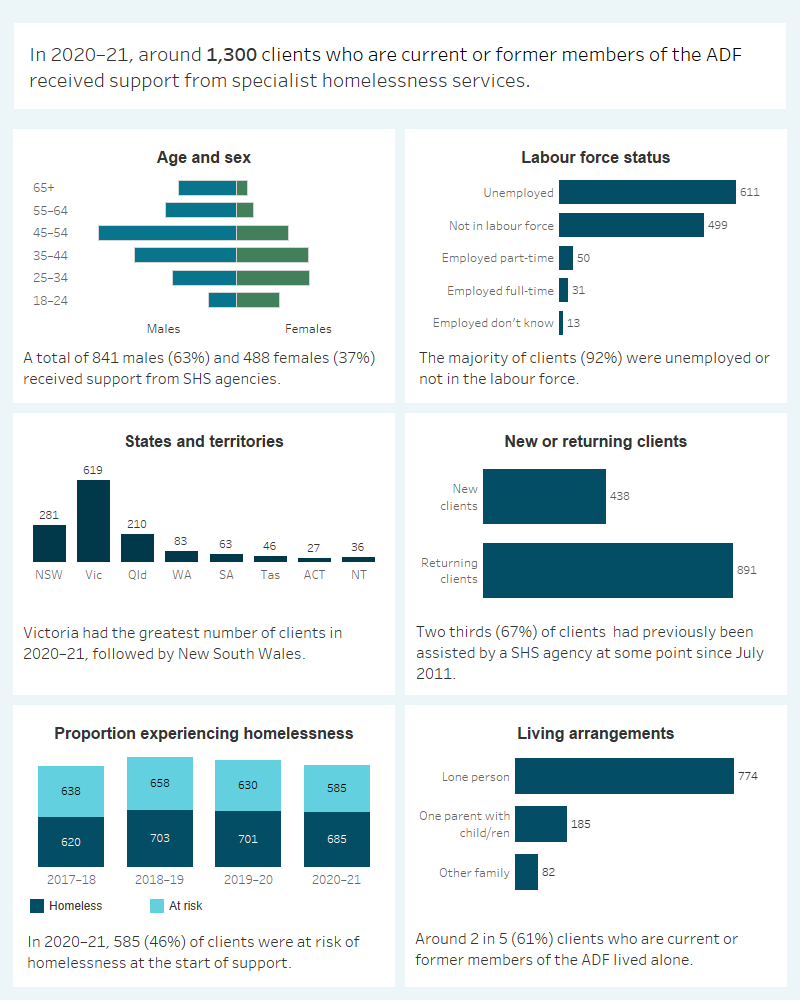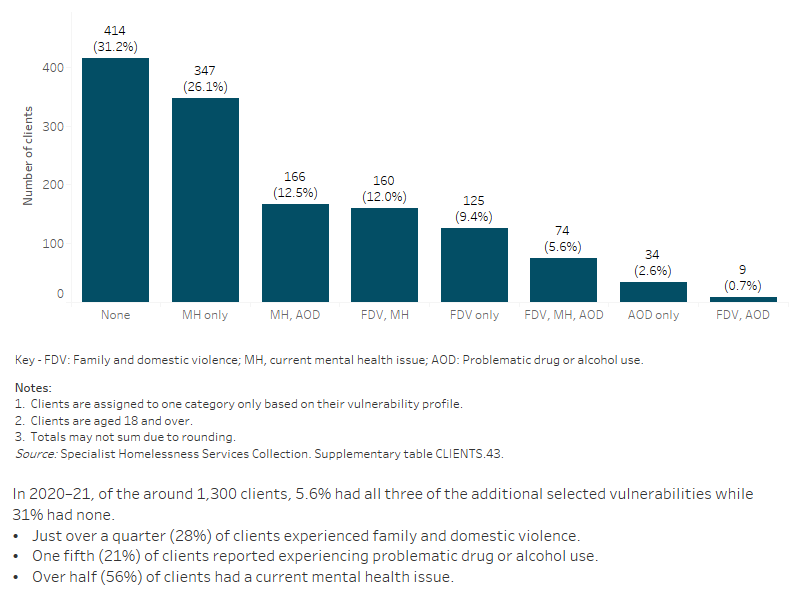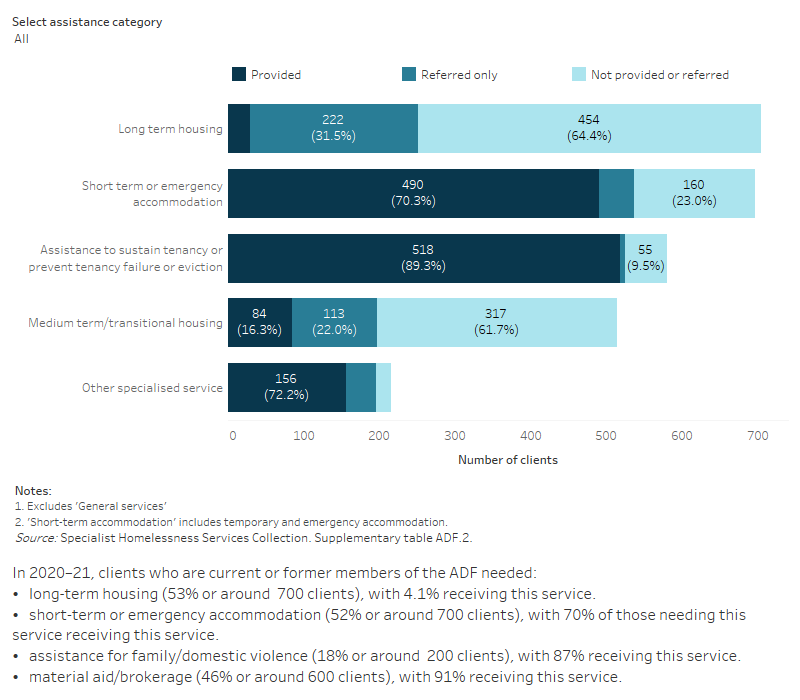Clients who are current or former members of the Australian Defence Force
On this page
Key findings: SHS clients who are current or former members of the ADF, 2020–21

The long-term welfare of Australian Defence Force (ADF) members is important as the nature of military service may result in serving and ex-serving personnel having been exposed to a greater number of risk factors that may influence their likelihood of experiencing homelessness, including:
- Complex personal needs – mental health issues and other complex vulnerabilities can be reflective of the unique demands of service (McFarlane et al. 2011).
- Financial stress – employment can become an issue for ADF members when transitioning from service to civilian life (Searle et al. 2019).
At 30 June 2020, there were more than 59,700 permanent current ADF members (Defence 2020). In addition, there were estimated to be around 622,500 living veterans, including all living persons who have ever served in the ADF either full-time or as reservists (DVA 2020).
Serving ADF personnel have access to housing and rental assistance through Defence Housing Australia. However, once personnel discharge from the ADF they are no longer able to access this housing support. Current or former ADF members can access a range of housing and homelessness services through government and non-government organisations, including access to reduced home loan rates and other benefits and discounts (Defence 2017).
To provide a better understanding of the extent to which current or former ADF members may need support from specialist homelessness services (SHS), the Australian Defence Force (ADF) indicator was introduced into the Specialist Homelessness Services Collection (SHSC) in July 2017.
It is important to note that variability in the implementation of this item has meant that coverage is still considered to be incomplete and limited analyses have been conducted to date. As is common with new data items, upon implementation there was a high number of ‘don’t know’ (14% in 2017–18) responses to the ADF question. In 2019–20, the number of ‘don’t know’ (9.0%) responses decreased, and decreased again in 2020–21 (8.0%). A ‘don’t know’ response is selected if the information is not known or the client refuses to provide the information. Expectations are that data quality will continue to improve over time, at which time further analyses may be undertaken.
The Use of homelessness services by contemporary ex-serving Australian Defence Force members 2011–17 report linked SHSC and Defence personnel data to identify contemporary ex-serving ADF members (those who discharged after 1 January 2001) who had used services between 2011–12 and 2016–17. The report provides a longer-term view of clients, prior to the implementation of the ADF indicator in the SHSC.
In 2020–21 (Supplementary table CLIENTS.37):
- SHS agencies assisted more than 1,300 clients who identified as current or former members of the ADF.
- Clients who identified as current or former members of the ADF made up less than 1% of all SHS clients.
Reporting ADF clients in the Specialist Homelessness Services Collection (SHSC)
The SHS ADF indicator is applied when a client self-identifies as a current or former ADF member. The ADF indicator is not applicable to clients who may have served in non-Australian defence forces, reservists who have never served as a permanent ADF member or clients under the age of 18. Note that differences between the results of this and other publicly reported estimates may be due to differences in how an ADF member is defined. Further details about the ADF indicator in the SHSC are provided in Technical information.
Client characteristics
Figure ADF.1: Key demographics, SHS clients who are current or former members of the ADF, 2020–21
This interactive visualisation describes the characteristics of the approximately 1,300 clients who are former or current member of the ADF who received SHS support in 2020–21. The majority of clients were male, aged 35–54. Most were unemployed. Victoria had the most clients, followed by New South Wales. The majority of clients had previously been assisted by a SHS agency since July 2011. More than half were experiencing homelessness at the start of support. Most were living alone.

Labour force status
In 2020–21, fewer than 1 in 10 clients (7.9%) with known labour force status and who identified as current or former members of the ADF were employed when they first presented to a SHS agency in the financial year. The majority of clients (51% or over 600 clients) were unemployed, while two fifths of clients (41% or around 500 clients) were not in the labour force (Supplementary table ADF.6).
Selected vulnerabilities
SHS clients can face additional vulnerabilities that make them more susceptible to experiencing homelessness, in particular family and domestic violence, a current mental health issue and problematic drug and/or alcohol use.
Figure ADF.2: Clients who identified as current or former members of the ADF, by selected vulnerability characteristics, 2020–21

Service use patterns
The length of support clients who identified as current or former members of the ADF received increased from a median of 53 days of support in 2017–18 to 64 days in 2020–21. These clients had an average of 3.0 support periods per client in 2020–21. The proportion of clients receiving accommodation increased from 36% in 2017–18 to 41% in 2020–21 for a median of 32 nights per client (Supplementary table CLIENTS.44).
New and returning clients
In 2020–21, clients were either presenting to SHS agencies for the first time as new clients or had previously been assisted by a SHS agency at some point since the collection began in July 2011.
Around a third of clients in 2020–21 were new (33% or over 400 clients), less than the general SHS population (39%) (Supplementary tables CLIENTS.2 and CLIENTS.38). One in 5 (21%) new clients were aged 45–54 years and an additional 1 in 5 (20%) were aged 35–44 years.
Of the 900 clients returning to SHS agencies for assistance, males were more likely to be aged 45–54 (32% or around 200 clients), while females were more likely to be aged 35–44 (28% less than 100).
Main reasons for seeking assistance
SHS agencies provide a range of support services. For clients who identified as current or former members of the ADF receiving SHS support in 2020–21 (Supplementary tables ADF.4 and ADF.5):
- The main reason for seeking assistance was housing crisis (21% or around 300 clients), followed by inadequate or inappropriate dwelling conditions (14% or around 200 clients).
- Both homeless and at risk clients identified housing crisis as either their main reason or second main reason for seeking assistance (26% or around 200 clients and 17% or almost 100 clients respectively).
- Clients at risk of homelessness were more likely to report financial difficulties as a main reason for seeking assistance (16%) than clients presenting as homeless (8%).
Services needed and provided
In 2020–21, the provision of support services to clients varied based on their identified need on presentation (Figure ADF.3, Supplementary table ADF.2):
- Advice/information was most likely to be needed by clients (89% or almost 1,200 clients) and was provided to 99% of those who needed it.
- More than 2 in 3 (70%) clients needed accommodation and it was provided to almost two thirds of those who needed it (60%).
Compared with the general SHS population, clients who identified as current or former members of the ADF were more likely to need:
- Advocacy liaison (70% compared with 55% in the general SHS population)
- Long term housing (53% compared with 39%)
- Short term or emergency accommodation (52% compared with 40%).
Figure ADF.3: Clients who identified as current or former members of the Australian Defence Force: services needed and provided, 2020–21
This interactive stacked horizontal bar graph shows the services needed by clients who identified as current or former members of the ADF and their provision status. Long term housing was the most needed service and the least provided. Assistance to sustain tenancy or prevent failure or eviction was the most provided service.

Housing situation
In 2020–21, of those clients who identified as current or former members of the ADF (Supplementary tables ADF.3 and CLIENTS.11):
- On presentation to services for assistance more than half of clients (54%) were experiencing homelessness (compared with 43% of the general SHS population):
- 21% (260 clients) were rough sleeping (compared with 8.7% of the general SHS population)
- 20% (around 250 clients) were in short-term or emergency accommodation (compared with 16% of the general SHS population).
- Just under half (46%) presented to services at risk of homelessness (compared with 57% of the general SHS population):
Defence (Department of Defence) 2020. Defence Annual Report 2019–20. Canberra: Department of Defence.
Defence 2017. ADF member and family transition guide: a practical manual to transitioning. Canberra: Department of Defence.
DVA (Department of Veterans Affairs) 2020. Department of Veterans’ Affairs Annual Report 2019–20. Canberra: Department of Veterans’ Affairs.
McFarlane A, Hodson S, Van Hooff M & Davies C 2011. Mental health in the Australian Defence Force: 2010 ADF Mental Health and Wellbeing Study: Full report, Department of Defence: Canberra.
Searle, A, Van Hooff M, Lawrence-Wood E, Hilferty F, Katz I, Zmudzki F & McFarlane A 2019. Homelessness amongst Australian contemporary veterans: pathways from military and transition risk factors, Australian Housing and Urban Research Institute (AHURI), Melbourne: AHURI.


